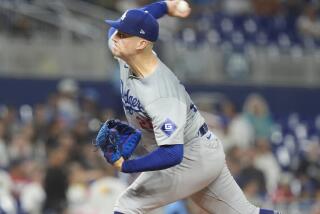Emphasis Put on Jury Selection in Second Miller Trial
- Share via
A huge jury panel of 216 members crowded into a federal courtroom Thursday as prosecutors and defense lawyers began the task of selecting a jury for the second espionage trial of former FBI Agent Richard W. Miller.
As the first step in the process, panel members were given a questionnaire that included screening tests devised by prosecutors to identify potential jurors with backgrounds similar to the juror who forced a deadlock in Miller’s first trial.
While two of the 12 jurors in the first Miller trial found him not guilty on three of the most serious espionage charges, only one juror refused to find Miller guilty of any of the seven related spying and bribery counts that he faced.
The holdout was Virginia Hennes, an Orange County mother of six working on a doctorate in the mental health field, and the new questionnaire reflected the prosecution’s belief that her mental health training made her sympathetic to Miller.
On the questionnaire, completed by the prospective jurors Thursday afternoon after they were told that they might be selected for the Miller retrial, was the following instruction:
“If you have taken more than an introductory-level course in any of the behavioral sciences (e.g., psychology, sociology, counseling, or similar areas), please identify such courses by subject matter or title.”
Jury selection is viewed by both prosecution and defense lawyers as critical because of the lopsided deadlock that produced a Nov. 6 mistrial at the end of the government’s first attempt to convict the only FBI agent ever charged as a spy.
Although the three-month trial ended in a setback for the government, prosecutors have termed the deadlock a “fluke,” suggesting privately that there was no way to have guessed that Hennes would be such a strong-willed holdout during the 14 days of bitter jury deliberations that preceded the mistrial.
Lawyers on both sides planned to carefully review the questionnaires over the weekend and will begin weeding out panel members Tuesday. By the end of next week, they said, they expect to have chosen a 12-member jury and six alternate jurors.
As U.S. District Judge David V. Kenyon, who presided over the first trial, told panel members that they were potential jurors in the Miller case, one slapped himself on the forehead, exclaiming: “My God!” Many of the jurors appeared to be unhappy at the prospect of serving as jurors for such a long time, and one asked Kenyon if they were going to be “locked up” during the trial.
“We don’t intend to sequester the jury,” Kenyon replied. “I would never want to sequester a jury, because it is hard on people. But I could not guarantee to any jury that it would never be sequestered. I would hope that nothing would happen that would cause that to happen.”
With Kenyon in the courtroom were the same prosecutors and defense lawyers who fought the first Miller trial. Also present was Miller, who has remained in federal custody at Terminal Island since his Oct. 2, 1984, arrest on charges of passing secret FBI documents to the Soviet Union.
U.S. Atty. Robert C. Bonner again led the prosecution team, joined by Assistant U.S. Atty. Russell E. Hayman, 27, one of the youngest of the more than 100 federal prosecutors in Los Angeles. Hayman emerged during the first Miller trial as one of the most combative courtroom lawyers in the U.S. attorney’s office.
Miller’s defense lawyers are Joel Levine and Stanley Greenberg. According to FBI statistics, their defense of Miller in his first trial produced the only mistrial in any espionage case in more than 40 years.
75 Witnesses in First Trial
The government called 75 witnesses in the first Miller trial to substantiate its claims that Miller had conspired with Soviet emigres Svetlana and Nikolai Ogorodnikov to pass secret FBI documents to the Soviet Union in exchange for a promised $65,000 in gold and cash and a new Burberry’s trench coat.
According to the government’s case, Miller had begun a sexual affair with Svetlana Ogorodnikova in May, 1984, and had traveled with her to the Soviet Consulate in San Francisco on Aug. 25, 1984, to pass a copy of the FBI’s Positive Intelligence Reporting Guide, a classified document outlining U.S. intelligence goals.
A massive FBI investigation into Miller and the Ogorodnikovs, code-named Whipworm, began a few days later. While it was proceeding, Miller voluntarily announced that he had been involved with Ogorodnikova in an effort to salvage his dismal career by becoming the first FBI agent in history to penetrate a Soviet KGB spy operation. The Ogorodnikovs were convicted in a trial that ended last June.
During a five-day period before his arrest, however, Miller allegedly confessed to a half-dozen FBI agents and polygraph experts that he had passed documents to Ogorodnikova. Miller also allegedly confessed to another of his girlfriends, Marta York, who testified along with the FBI agents in Miller’s first trial.
Still banned from discussing the case because of a gag order imposed by Kenyon last year, neither the defense nor the prosecution would say if they planned any changes in strategy for the coming trial.
More to Read
Sign up for Essential California
The most important California stories and recommendations in your inbox every morning.
You may occasionally receive promotional content from the Los Angeles Times.













